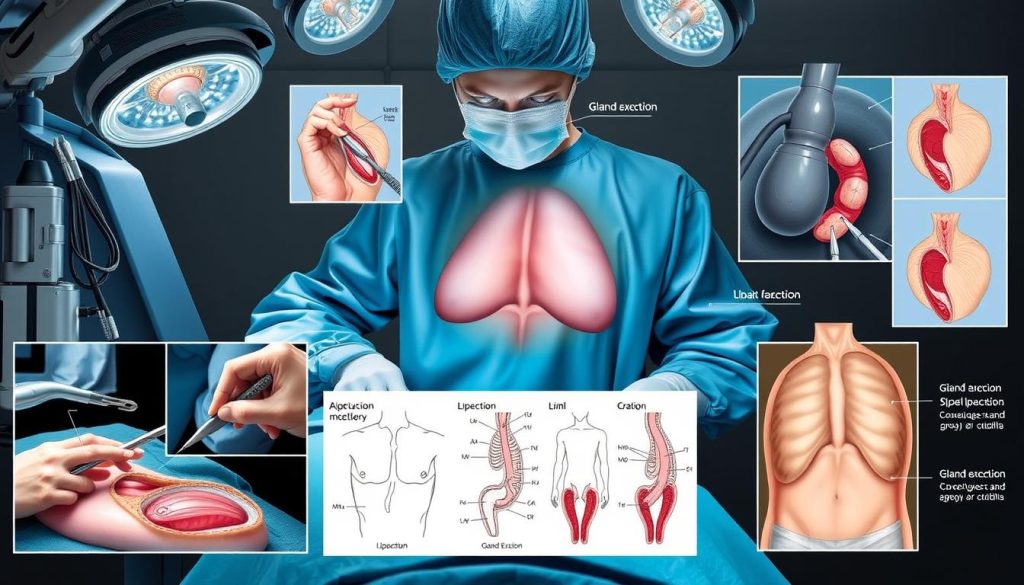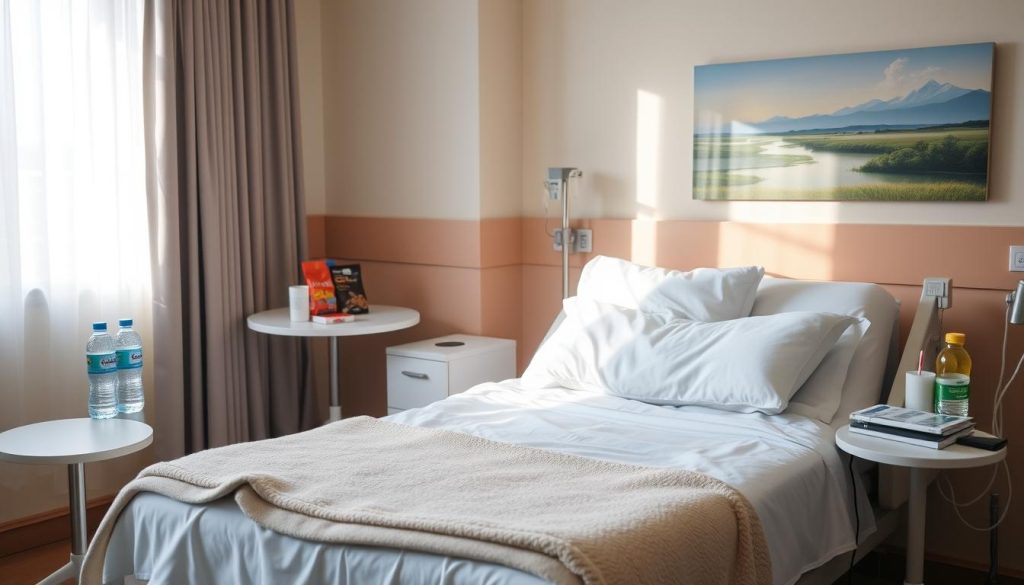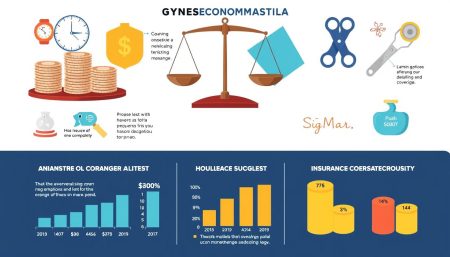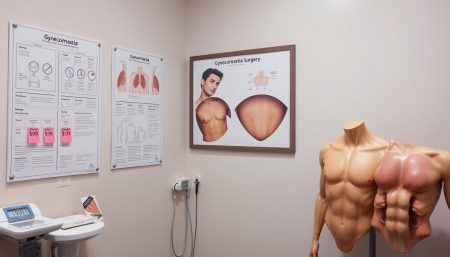The journey to recovery after gynecomastia surgery is important. It requires careful attention to post-op care. This path is filled with patience and following doctor’s orders to smoothly return to daily life.
The time it takes to heal varies from person to person. It depends on health and the surgery’s complexity. So, it’s key to have realistic expectations and know the healing milestones.
Patients aim for a better chest shape and more confidence. They must carefully go through the postoperative period. Each recovery is unique, so doctors give personalized advice.
We understand the emotional and physical challenges of healing. Our goal is to provide the knowledge and support needed for a full recovery.
Key Takeaways
- The recovery period post gynecomastia surgery is critical for the overall success of the procedure.
- A personalized gynecomastia surgery recovery timeline plays a key role in returning to daily activities smoothly.
- Post-op care for gynecomastia surgery is crucial for a comfortable and safe healing process.
- Realistic expectations must be set, considering that individual healing times can significantly vary.
- Professional guidance tailored to each patient helps navigate the intricacies of postoperative healing.
- Emotional support and compassionate understanding complement the medical expertise provided to patients.
Understanding Gynecomastia and Its Treatment
Gynecomastia is when a man’s breast tissue gets bigger. It’s a mix of physical and emotional challenges. The main cause is an imbalance of hormones like estrogen and testosterone. Knowing about the condition and treatment options is key to a smooth recovery.
What is Gynecomastia?
Doctors at the Mayo Clinic say gynecomastia is swelling in a man’s breast due to hormone imbalances. It can happen in one or both breasts and may not be even. It’s common in teens but can happen at any age, making it important to understand.
Causes of Gynecomastia
There are many reasons for gynecomastia. Harvard Health Publishing says it can be due to natural changes, like puberty, or from medicines or health issues. Each reason affects treatment differently.
Importance of Surgical Intervention
The American Society of Plastic Surgeons sees surgery as a key treatment for gynecomastia. While non-surgical methods can help, surgery is often needed for lasting relief. It removes extra tissue, easing discomfort and boosting confidence.
For more on recovery, check out this guide on the gynecomastia surgery healing. It offers detailed care tips for after surgery.

The Gynecomastia Surgery Procedure
Exploring gynecomastia surgery reveals the detailed steps involved. It shows the surgical methods and what you need to do before surgery. Knowing what happens during surgery can make you feel less anxious about the healing process and recovery time.
Types of Surgical Techniques
Johns Hopkins Medicine explains that there are two main ways to fix gynecomastia: liposuction and excision. Liposuction removes extra fat, while excision is for glandular tissue or excess skin. The right method depends on how bad the gynecomastia is and the type of breast tissue.
Choosing the right surgery method is key. It helps get the best results with less scarring and better looks.
New techniques in liposuction and excision make scars heal faster. This also means you can recover quicker and look better after surgery.
Preoperative Preparations
The Mayo Clinic lists important steps before gynecomastia surgery. Patients should change their medications, stop smoking, and avoid certain drugs and supplements. They might also get diet advice to help with the surgery and recovery.
- Medication adjustments and cessation of smoking
- Dietary adjustments to minimize surgery risks
- Arrangements for post-surgery care and transportation
Good pre-surgery prep is crucial. It helps you recover faster and heal better from the surgery scars.

Immediate Post-Operative Recovery
Recovering from gynecomastia surgery needs careful post-operative care for the best results. Patients must be ready for the immediate aftermath, including managing pain and discomfort. Knowing the timeline for gynecomastia surgery recovery and following gynecomastia surgery recovery tips helps a lot.
What to Expect Immediately After Surgery
Right after surgery, you might feel sore and swollen. Doctors suggest wearing compression garments to lessen swelling and support your chest. It’s crucial to follow these tips closely for the best healing and shape.

Initial Pain and Discomfort Management
Managing pain is key after surgery. The American Society of Plastic Surgeons says the right pain meds will be given. Rest and careful activity are also important. Always follow your surgeon’s aftercare advice, including taking meds and going to follow-up visits.
| Day Post-Surgery | Expected Sensation | Recommended Action |
|---|---|---|
| 1-3 | Mild to moderate pain | Take prescribed pain medications, rest, and wear compression garments |
| 4-7 | Decreased pain, possible itching as incisions heal | Continue with medications, begin gentle walks, avoid strenuous activities |
| 8-14 | Reduced swelling, more mobility | Slowly resume non-strenuous daily tasks, follow-up consultation |
This table shows a basic timeline for gynecomastia surgery recovery. It outlines important stages and what to expect. Remember, everyone’s recovery is different. Always talk to your healthcare team for advice tailored to you.
First Week After Gynecomastia Surgery
The first week after gynecomastia surgery is key for a smooth recovery. It’s important to follow the right post-op care to heal faster and avoid problems.
Typical Healing Timeline
Knowing how long it takes to heal from gynecomastia surgery helps set realistic recovery goals. In the first few days, you might see some swelling and bruising. These will get better over time. Managing pain is crucial, and your surgeon will likely give you medicine for this.
You’ll also have a follow-up visit to check on your healing and remove any stitches if needed.
Activities to Avoid During Recovery
To avoid putting strain on the surgery area, it’s important to know which activities to skip. Here’s a list of things to avoid in the first week:
- Heavy lifting or carrying objects over 10 pounds
- Strenuous exercise, including jogging, biking, or weight training
- Any form of chest compression or tight clothing that can irritate the surgery area
- Sleeping on your stomach or any position that puts pressure on the chest
| Activity | Recommendation |
|---|---|
| Physical exercise | Avoid until medical clearance |
| Carrying heavy objects | Lift nothing heavier than 10 pounds |
| Sleeping positions | Prefer back-sleeping to avoid pressure on the chest |
| Dressing | Wear loose-fitting clothing to reduce irritation |

Following these guidelines helps your body heal faster and reduces the chance of complications. It makes your recovery more comfortable. Listening to your surgeon’s post-op care instructions is crucial for a smooth healing process. Many people who carefully followed these steps had quicker recoveries and were happy with their results.
Monitoring for Complications
As patients go through the gynecomastia surgery healing process, it’s crucial to stay alert. This helps ensure a smooth and safe recovery. Spotting early signs of complications can greatly affect the surgery’s success and the patient’s health.
Signs of Infection to Watch For
Post-operative infections are a big worry. The American Society of Plastic Surgeons says to watch for signs like increased redness, swelling, and unusual discharge at the surgery site. Fever and growing pain are also warning signs that need quick action.

Managing Unexpected Side Effects
Recovery tips go beyond just fighting infections. Some patients might face other side effects, like numbness, uneven skin, or color changes. Healthline says these can be uncomfortable but usually not serious. It’s important to keep an eye on these and talk to your surgeon if they don’t go away.
| Complication | Symptoms | Recommended Action |
|---|---|---|
| Infection | Redness, swelling, discharge, fever, increased pain | Contact surgeon immediately, possible antibiotic treatment |
| Numbness | Lack of sensation in the chest area | Typically temporary; monitor and report if persistent |
| Contour Irregularities | Uneven surface of the chest | Discuss potential corrective measures if condition persists |
| Color Changes | Darkening or redness of the skin | Observe for progression, consult with surgeon if increased |
Knowing about these possible issues and following good recovery tips can really help. It can lead to better results with fewer problems.
Returning to Daily Activities and Exercise
After gynecomastia surgery, knowing when to get back to normal is key. Everyone recovers differently, based on the surgery and their health. We’ll look at when and how to start doing daily tasks and exercising again.
When to Resume Normal Activities
The American Board of Cosmetic Surgery says most people can go back to work and do light tasks in a few days to a week. But, always talk to your surgeon first. They’ll make sure you’re ready to start again safely.
- Go back to work in a week if your job isn’t hard.
- Stay away from heavy lifting and hard activities for 3-4 weeks.
- Slowly add more to your daily routine with your doctor’s help.
Guidelines for Physical Exercise After Surgery
Starting to exercise after surgery needs careful thought. Experts from Bodybuilding.com say to:
- Start with easy walks right after surgery to keep blood flowing.
- Avoid exercises that press on your chest for 3-4 weeks.
- Start doing more exercises after 4-6 weeks, but only with a doctor’s okay.
Following these steps helps you recover well. It lets you get back to your usual life and activities safely.
| Activity | Post-Surgery Timeline | Additional Notes |
|---|---|---|
| Light walking | Immediately | Encouraged to prevent blood clots and promote healing |
| Return to work | 1 week | Depending on the nature of the job |
| Heavy lifting | 3-4 weeks | Avoid to prevent stress on surgical sites |
| Moderate exercises | 4-6 weeks | Resume under guidance to ensure correct healing |
It’s crucial to stick to these guidelines and talk to your doctor. They can make a recovery plan that’s right for you, helping you heal well and get the best results.
Long-Term Healing and Results
Understanding the recovery journey after gynecomastia surgery is key. It helps set realistic expectations and manage discomfort. The healing process is influenced by many factors, each crucial for the surgery’s success.
Factors Affecting Healing Time
A study in the Plastic and Reconstructive Surgery Journal shows healing times vary. Age, health, and surgical technique are major factors. Younger patients tend to heal faster because of higher collagen levels.
Adjustments in Appearance Over Time
RealSelf feedback reveals changes in appearance after surgery evolve. Swelling and bruising are initial signs, while long-term changes include scar healing and skin retraction. These changes stabilize over months. Patients see improvements in body shape and feel a more natural chest area.
Following post-operative guidelines and regular check-ups is crucial for recovery. Managing discomfort and ensuring scar healing are vital for good results. This highlights the need for patience and following medical advice during healing.
Follow-Up Appointments and Aftercare
Knowing how to heal after gynecomastia surgery is key for a good recovery. These follow-up visits are crucial to check on your healing and handle any issues early.
Importance of Regular Check-Ups
Regular visits after surgery help ensure you’re healing well and catch any problems fast. These meetings let doctors check how your wounds are healing and talk about any worries. They also help you understand how long it takes to heal, setting realistic recovery goals.
Tips for Optimal Healing Post-Surgery
Following your surgeon’s advice is important to reduce recovery time and get the best results. Here are some top tips from experts:
- Eat a diet full of vitamins and proteins to help your body fix itself.
- Drink lots of water all day to stay hydrated.
- Don’t smoke or drink alcohol, as they can slow healing.
- Rest well and avoid hard activities until your surgeon says it’s okay.
These easy steps can greatly affect your recovery time. Every person heals differently, but following these tips can make your recovery smoother and faster.
Emotional and Psychological Recovery
Healing after gynecomastia surgery is more than just physical. It also involves emotional and psychological healing. Resources like Psychology Today help understand the complex emotions that arise. It’s important to acknowledge and accept these feelings for a complete recovery.
Coping with Body Image Changes
Adjusting to body changes after surgery can be tough. It’s influenced by personal views, societal norms, and the need to accept oneself. During the recovery, being kind to oneself and setting achievable goals is key. This helps build a positive body image and boosts self-confidence.
Support Systems and Counseling Recommendations
Strong support systems are crucial, as the American Cancer Society points out. Having caring family, friends, or support groups helps a lot. Professional counseling also offers valuable guidance and strategies. With a supportive network, patients can better manage the emotional side of recovery, making it more manageable and resilient.
FAQ
Q: How Long Does It Take to Heal From Gynecomastia Surgery?
A: Healing from gynecomastia surgery takes time. You’ll see big improvements in the first few weeks. Most people can go back to normal activities in a few days to a week, if they follow their surgeon’s advice.
It might take several months for all the swelling to go down and for the scars to fade. This is when you’ll see the final results.
Q: What is Gynecomastia?
A: Gynecomastia is when boys or men have swollen breast tissue. It happens when there’s an imbalance of hormones, like estrogen and testosterone. This condition can make people feel uncomfortable and self-conscious.
Q: What Causes Gynecomastia?
A: Hormonal changes are the main reason for gynecomastia. It can also be caused by certain medicines, illegal drugs, and health issues. Being overweight, getting older, or using steroids can make it worse.
Q: Why is Surgical Intervention Important for Gynecomastia?
A: Surgery is key for those who don’t get better with other treatments. It removes extra breast tissue and makes the chest look more masculine. This can really help with how you feel about yourself.
Q: What Types of Surgical Techniques are Used to Treat Gynecomastia?
A: There are two main ways to fix gynecomastia: liposuction and excision. Liposuction gets rid of fat, while excision removes glandular tissue or extra skin. The choice depends on what’s in your breasts.
Q: How Should Patients Prepare for Gynecomastia Surgery?
A: Before surgery, you might need to change your meds, stop smoking, and avoid some drugs to lower bleeding risk. Make your home ready for recovery, get help for after surgery, and follow a special diet.
Q: What Can Patients Expect Immediately After Gynecomastia Surgery?
A: Right after surgery, you’ll feel sore, swollen, and bruised. You’ll need to wear a special garment to help your chest heal. Resting and taking your meds as directed is important.
Q: How is Initial Pain and Discomfort Managed After Surgery?
A: To manage pain and discomfort, you’ll take pain relievers and anti-inflammatory drugs as prescribed. Resting, using cold compresses, and gentle walking help too. Avoid hard activities until your doctor says it’s okay.
Q: What is the Typical Healing Timeline During the First Week After Surgery?
A: In the first week, rest a lot and avoid hard activities. You’ll have a follow-up to check on healing and remove sutures if needed.
Q: What Activities Should be Avoided During Recovery?
A: Stay away from hard exercise, heavy lifting, and anything that strains your chest. Following your surgeon’s advice helps you heal smoothly.
Q: What are the Signs of Infection to Watch For After Gynecomastia Surgery?
A: Watch for signs like more redness, warmth, fever, unusual discharge, or more pain. If you see these, call your surgeon right away.
Q: How Are Unexpected Side Effects Managed?
A: If you get unexpected side effects like numbness or changes in your chest, talk to your surgeon. They can help. Following your post-op instructions helps avoid these problems.
Q: When Can Normal Activities and Exercise be Resumed After Surgery?
A: You can usually go back to normal activities in a few days to a week. Start with light exercise and gradually get back to your routine as your doctor advises.
Q: What Factors Affect Long-Term Healing and Results?
A: How well you heal depends on following your surgeon’s advice, your health, age, and the surgery type. Your diet, exercise, and not smoking also play a big part.
Q: How Do Adjustments in Appearance Evolve Over Time?
A: It takes months for scars to heal and skin to settle. It can take up to a year for the final look to be complete, with scars getting better and the chest shape improving.
Q: Why are Regular Check-Ups Important After Gynecomastia Surgery?
A: Regular visits help track your healing, catch any problems early, and make sure you’re happy with the results. They’re a chance to talk about any concerns and get advice for ongoing care.
Q: What Tips Can Help Promote Optimal Healing Post-Surgery?
A: Eat well, drink water, avoid smoking, and don’t drink too much alcohol. Rest a lot and take gentle walks to help your body heal. But don’t do too much until your doctor says it’s okay.
Q: How Can Patients Cope with Body Image Changes After Surgery?
A: Give yourself time to get used to your new look. Talk to friends, family, or support groups. If you’re really struggling, see a mental health professional for help.
Q: What Support Systems and Counseling Recommendations are Available for Post-Surgery Emotional Recovery?
A: There are counseling services, support groups, and resources from places like the American Cancer Society. They can help you deal with the emotional changes after surgery.

















